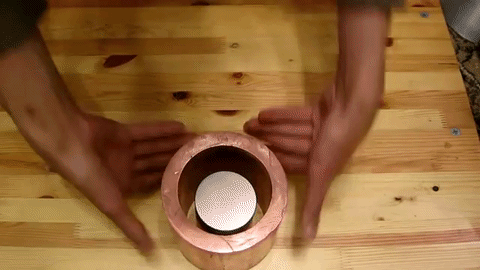
Escape the ordinary

PHYSICA

DIY Experiments: Edition I
Intro: We study physics in an attempt to understand the inner workings of the universe. Everything we do, no matter how small or mundane, is governed by the laws of nature. Yet, the vital role that physics plays in our daily lives tends to go unnoticed. With these two fun experiments, you can witness the display of fascinating physical phenomena with very basic materials and in the comfort of your own home!
1. Demonstrating Bernoulli’s Principle
Have you ever wondered how massive airplanes are able to fly as if they were weightless? The theory behind this is actually more complex than you might think, and it relates to one of the most important topics in fluid dynamics, Bernoulli’s principle.
In simple terms, Bernoulli’s principle states that fast moving air has less pressure than slow moving air. This is because the particles in fast moving air are stretched out, while in slow moving air they are closer together, causing a difference in pressure. If you want to see this effect in action, you can do a this simple experiment only using a hairdryer and a ping pong ball.
Floating Ball Experiment

Step 1: Plug your hairdryer into an outlet, and have your ping pong ball ready.
Step 2: Turn the hairdryer on and adjust the settings so that it is blowing out a strong, steady stream of air. Aim the nozzle upward at a slight angle.
Step 3: With the hairdryer on, hold the ping pong ball at the center of the airflow with your hand, and let go.
Step 5: If the ball does not stay in the airflow, try to adjust the hairdryer settings.
Step 6: Once you get the ball steady in the stream, try to experiment with different angles and observe how the ball moves.
What’s Going On?
To understand what is happening, you’ll need to be able to visualize the airflow around the ping pong ball with the help of the following diagram.

The blue arrows represent the surrounding air at atmospheric pressure. The gray arrows represent the fast moving air coming from the hairdryer. According to Bernoulli’s principle, the faster moving air has less pressure relative to the still, surrounding air. The ball stays in the airstream because the surrounding atmosphere is at a higher pressure which creates an inwards force from the sides of the ball towards the center. The height the ball reaches is determined by the equilibrium between its weight, and the upwards force by the air.
2. Witness Lenz’s Law
Electromagnetic induction is one of the most useful and transformative discoveries in Physics in terms of its real world applications. We use it to cook our food, recharge our smartphones, separate waste, and to generate electricity. We can thank Michael Faraday for his discovery of induction, when he saw that a moving magnet would induce an electric current in a coil.
This did raise some questions about the conservation of energy. Imagine a magnet is falling downwards through a coil. It starts at a certain height above the ground with a certain amount of potential energy, and this potential energy transforms into kinetic energy as it falls. The magnet’s movement would be generating electrical energy in the coil seemingly out of thin air. Clearly this would be against energy conservation, so there must be an exchange of energy to generate this electricity. Lenz’s law is a consequence of this concept, which you’ll be able to witness with this very simple experiment.
Magnet Drop Experiment

Step 1: You’ll need a roll of aluminium foil, and a magnet that can fit inside the tube of aluminium without scraping the sides. Keep in mind that the thicker the aluminium foil, the better. If it only has a few rolls left, you might want to use a new roll.
Step 2: Place the aluminium foil down vertically on a flat surface, so that the tube is facing up.
Step 3: Position the magnet above the opening of the tube, and let go! You won’t need a stopwatch to notice that the magnet falls much slower when its inside the aluminium tube.
Step 4: If you do not notice the magnet slowing down, you may need a stronger magnet or a thicker roll of aluminium.
What’s Going On?
We know that aluminium is non-magnetic, but it is also a metal and can therefore conduct electricity. The falling magnet causes a change in magnetic flux, and from our prior knowledge of electromagnetism, we know that this changing magnetic flux induces an electric current in the conductor called an Eddy current. This is where it gets more complicated. This Eddy current travels in loops around the aluminium, making it act as a coil, which will generate it’s own magnetic field. According to Lenz’s law, this magnetic field will always oppose the direction of the magnet that produces it.
When the magnet is at the top half of the aluminium foil, it is slowed by the repulsion of the same pole, and in the bottom half it is slowed by the attraction between opposite poles. This way, the work done on the magnet by the induced current is what turns into electrical energy, and no energy conservation laws are broken.
